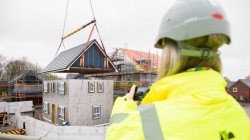As a result of the collaborative approach adopted by the project team, the scope of the AIMCH project has evolved, meaning new, innovative workstreams have been added including topics such as embodied carbon, the use of augmented and mixed reality and whole of life costing. The work we are currently pioneering has the potential to drive wider impact on the industry, on how we build, monitor and improve our homes.
A key success over the past year has been prototyping panelised systems on live builds. Several closed panel timber frame units were delivered on a live development near Warrington and Milton Keynes by AIMCH partners Barratt Developments and L&Q. On the Barratt development site, two of the units were also erected without any scaffold, as well as the roof being pre-tiled on the ground before being lifted into place - a first for Barratt as a company.
Prime Minister Boris Johnson visited the development in August this year and had chance to see the AIMCH prototype homes being constructed using advanced Modern Methods of Construction.
All six homes are now complete, sold and being lived in - a fantastic achievement and a great result for the AIMCH project, Barratt and partners.
Another AIMCH prototype build is progressing at L&Q's Saxon Reach development in Milton Keynes, where all 225 properties on-site - ranging from one-bedroom apartments to five-bedroom homes - are being constructed using Stewart Milne Timber Frames' offsite panelised systems.
These offer a more energy efficient build and significantly lower running costs for new residents, helping to tackle issues such as fuel poverty and significantly reduce household bills. Several innovations are being trialled including pre-fabricated party wall system and a fire safe closed panel solution for apartments. Product testing is underway to validate the systems being trialled to ensure they meet all the requirements of future regulatory demands, such as energy, whole life cost, embodied carbon and building safety requirements.
The approach from both AIMCH partners has allowed better quality homes to be delivered quickly, particularly important in areas that are experiencing significant population and employment growth over recent years. Something we hope to see rolled out across the whole of the UK, so the data that is being collected now by AIMCH is key.
Digital technology also plays a pivotal role in the AIMCH project, where automotive learning from around the world is being used to develop advanced manufacturing approaches, such as simulation, to build a model of the "future offsite factory" where digital technology and automation such as robotics drives productivity, lowering production costs and increasing capacity.
The development of BIM has also changed the way that construction companies interact with data and is helping them to understand its true value. The sector is growing more aware of the value of creating, gathering and analysing data. Access to more reliable and plentiful information helps companies make informed decisions about processes, materials and improve productivity, reduce costs and increase sustainability during construction projects.
The AIMCH project is at the forefront of change and we are well down the line on developing a guide to creating a BIM Housing Manual for developers, that will be specific to housing developments. Organisations will be able to use this manual to create a digital representation of the physical and functional characteristics of a building and we will be trialling this with partners towards the end of 2020.
These technological changes mean we also need a workforce equipped with the necessary skillset to support the transformation in housebuilding and construction industries. This brings the opportunity to attract new talent with digital, logistics, engineering, design, robotics, BIM, supply chain and project chain management skills, making the sector more appealing and creating a diverse workforce. These new, smarter ways of working will help the industry to achieve more with less, the need for which has been highlighted even more this year as the industry adapts to working through ongoing Covid-19 restrictions.
It has been a challenging year for the sector, yet despite this, we are achieving fantastic outcomes. Much has been achieved since the AIMCH project started 18 months ago and we are incredibly excited about the next part of the journey, where we will be looking at creating a future factory model, design standardisation, studying productivity, commercial viability, embodied carbon and implementing new technologies.
For example, one of the new technologies currently being tested by AIMCH partner Forster Roofing is the digitisation of an innovative roof tiling system using augmented reality that will help to improve productivity in terms of the speed at which roof tiles and renewable systems can be fitted. The opportunities for the sector really will be transformational and we will continue to collaborate with industry partners.
We will drive the adoption of Modern Methods of Construction by de-risking it for small-to-medium businesses, making construction a more digitally integrated, manufacturing and assembly-based sector that delivers the required high volume of sustainable quality homes that society needs.
Stewart Dalgarno
Project director
Advanced Industrialised Methods for the Construction of Homes
www.aimch.co.uk
Source: PBC Today









